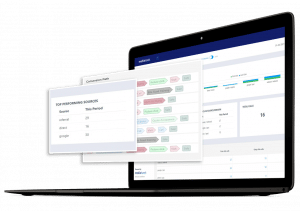Three marketing attribution mistakes agencies make every day
Marketing attribution. We’ve written about it a lot at Mediahawk – from our straight-talking piece about what marketing attribution is, to our four handy ways to link your marketing activities to revenue. Not to mention how to understand and attribute campaign performance at that elusively messy middle stage of the buying journey.
It’s something that, as a marketing agency, you have to be up to speed on. Being able to link every single lead and sale to their source will be your secret weapon when that inevitable question comes up during your next client meeting: “What return am I getting from all this?”
Yes, that question. It’s an anxiety-inducing demand that can leave even the most seasoned agency pro hot under the collar. If you’re not fully prepared, you’ll find yourself scrabbling around in Google Analytics looking for evidence that the summer 2020 campaign did bring in new business for your client. (If it did during the height of a global pandemic, give yourself a big pat on the back!)
Even if you can show the ROI of your hard work, are you sure you’re reporting on every lead and sale? If your marketing attribution models don’t take the entire customer journey into account, you may be reporting inaccurate ROI to your clients (more on this later).
When marketing attribution drives client retention
We all know the fragility of the client/agency relationship. Marketing budgets are usually the first to be tightened when a business needs to save cash. What was once a highly profitable, long-term client can quickly become an empty row in your agency’s retainer income spreadsheet – sometimes overnight.
But if you’re hot on constantly reminding clients of the ROI you’re delivering, they’ll be much more likely to stay with you whatever budget cuts come their way. They may even come to see you as an extension of their team that they can’t do without.
So how do you make sure you’re reliably reporting on leads and sales generated from your campaigns? How do you achieve that holy grail of 100% attribution?
Are you making these marketing attribution mistakes?
Successfully attributing marketing leads and sales to their sources can be a nightmare, we know. But the technology exists to smooth the process for you and deliver the client-wowing insights you’ve been looking for.
With that in mind, there’s no reason why you should need to make these three marketing attribution mistakes anymore.
1. Not joining up online and offline channels
If you don’t have reliable attribution mechanisms in place, you won’t be reporting the whole picture to your clients. A so-so campaign in terms of leads generated may be your best campaign yet. But you won’t know if you aren’t attributing all leads correctly. Yes, you may be able to see where your digital conversions come from – paid ads, social media posts, email newsletters etc. But what about all the hidden, offline enquiries you received? If your clients’ customers are seeing paid ads in search engines, but then picking up the phone to speak to your client rather than clicking a link, you need to have visibility of that, too. These conversions are the ones that could mean the difference between you giving your client a great ROI or an average or poor one.
2. Not drilling down to individual prospect level
With call tracking software, you can track and attribute the actions of each of your clients’ prospects. With this, it’s possible to see where individual engagement happens. You’ll know when your clients’ prospects switch from particular events or online ads to ebooks or videos and web pages, for example – before they finally pick up the phone or order online. Not only does this help you pinpoint the sources that deliver the best returns, it also gives you valuable insight into the behaviour of specific customer groups. It’s something with which you can wow your client during that next strategy meeting.
3. Not assigning true value to assisted clicks
First-click and last-click attribution models are often preferred among marketers because they’re easier to use and you don’t need to be technically minded to see what’s going on. But they assign all the value of the conversion to either the first step a prospect takes or the last click. This doesn’t take into account the non-linear buying journeys we all make in the modern, digital world. The middle stage of the buying journey, in particular, can be particularly difficult to follow and attribute value. Using Google’s attribution models, you can assign weighting in different ways. But what if each visitor takes a specific route towards the first ad impression that does not correlate with the journeys other visitors are taking? When this happens, measuring intent based on impressions, ads clicked and URLs visited is often left to guesswork. With call tracking and lead attribution software, you can track individual prospect journeys from start to finish. This means any call-to-action (whether online and offline) can show a summary of assisted click interactions – not just the first or last click.
So next time you’re building that monthly report for your biggest client, ask yourself whether the results you’re presenting give a true picture of your hard work. Or are you missing hidden leads and sales that could push their ROI higher than ever?

Take a look at the Mediahawk features marketing agencies love and book a 15-minute, no obligation demo today.



